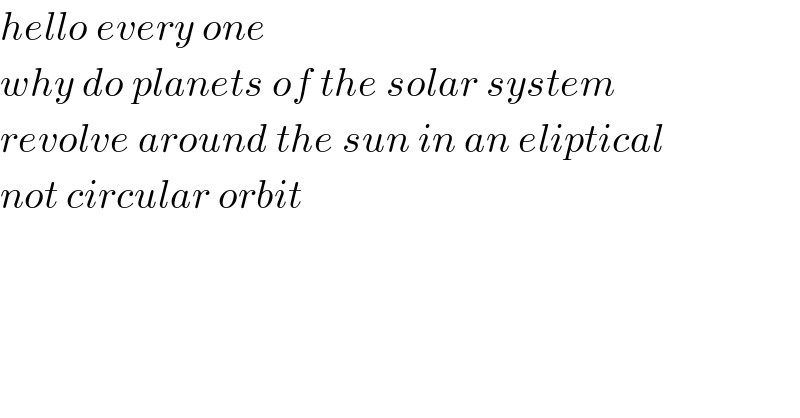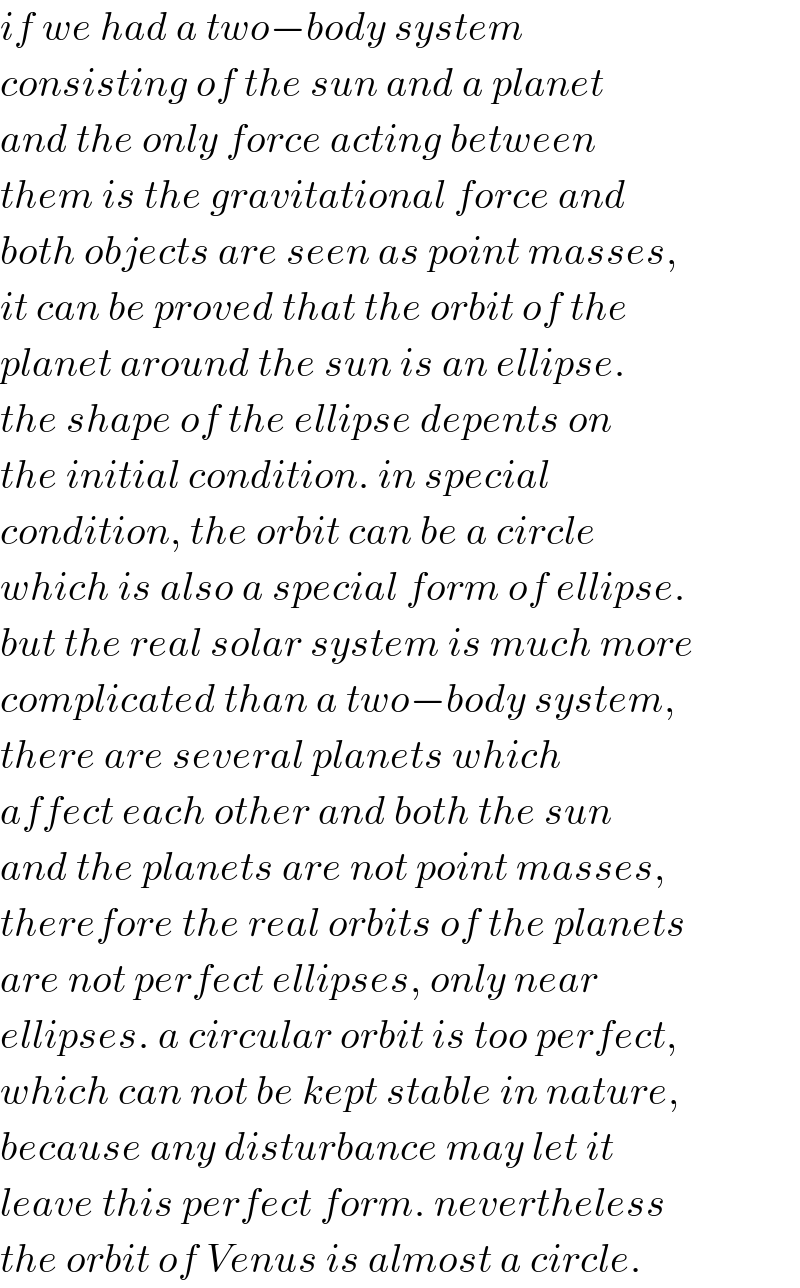
Question and Answers Forum
Previous in Matrices and Determinants Next in Matrices and Determinants
Question Number 97271 by M±th+et+s last updated on 07/Jun/20

Commented by mr W last updated on 07/Jun/20

Commented by M±th+et+s last updated on 08/Jun/20

Answered by Sourav mridha last updated on 07/Jun/20
![okk let′s see the trajectory of body moving in central force field...but Here i am not using GTR..only the point of view of old classical concept of Newtonian Lagrangian Mechanics. let′s pick up the example of our solar system....where sun is at the focus and earth moves round sun in account of Gravitational force feild. so our Lagrangian constracted in plane polar coordinate like that L=(1/2)[(r^• )^2 +r^2 (𝛉^• )^2 ]−v(r) now using Euler−Lagrange eq^n (from Variational calculas) (∂L/∂r)−(d/dt)((∂L/∂r^• ))=0 and (∂L/∂𝛉)−(d/dt)((∂L/∂𝛉^• ))=0 from 1st eq^n we get r^(••) −r(𝛉^• )^2 =−(∂/∂r)[v(r)]=F(r)=(k/r^2 ) .................(i) F(r)=gravitetional force ,k=constant k=Gm_s m_e . and 2nd eq^n gives us r^2 𝛉^• =constant,multi:𝛍 both sides we get L=𝛍r^2 𝛉=constant ...........(ii) where 𝛍=((m_s m_e )/(m_s +m_e ))=reduce mass for central force− torque 𝛕 =r^→ ×f(r)=0 or (dL/dt)=constant where L=angular momentam. now let u=(1/r) now diff wrt to 𝛉 and using eq^n (ii) we get (du/d𝛉)=((−1)/r^2 ).((dr/dt)/(d𝛉/dt))=−(1/r^2 )(r^• /𝛉^• )=−(𝛍/L)r^• now (d^2 u/d𝛉^2 )=−(𝛍^2 /(L^2 u^2 )).r^(••) . so we get r^(••) =−((L^2 u^2 )/𝛍^2 ).(d^2 u/d𝛉^2 ) and r(𝛉^• )^2 =((u^3 L^2 )/𝛍^2 )... now putting this two results at eq^n (i) we get eq^(n ) of motion of earth around sun is (d^2 u/d𝛉^2 )+u=−((𝛍^2 k)/L^2 )(constant) by solving this easy 2nd ODE we get u(𝛉)=−((𝛍^2 k)/L^2 )+Acos𝛉+Bsin𝛉 or =−((𝛍^2 k)/L^2 )+𝛄cos𝚽 we considerate at first u=(1/r) so now r(𝚽)=(1/(−((𝛍^2 k)/L^2 )+γcos(𝚽))) =((−(L^2 /(𝛍^2 k)))/(1−((L^2 𝛄)/(μ^2 k))cos(𝚽))) compare this result with eq^n of a ellipse in plane polar coordinate r(𝛉)=(l/(1+_− ecos(𝛉))) in our case−− sami letus rectum of the ellipticak path of our planet is l=a(1−e^2 )=−(L^2 /(𝛍^2 k)) and escentricity e=((L^2 𝛄)/(𝛍^2 k)) this is why planets arw moving in a elliptical path... 1st proposed by Kepler in his 1st las of planetory motion..](Q97384.png)
Commented by smridha last updated on 08/Jun/20

Commented by M±th+et+s last updated on 08/Jun/20

